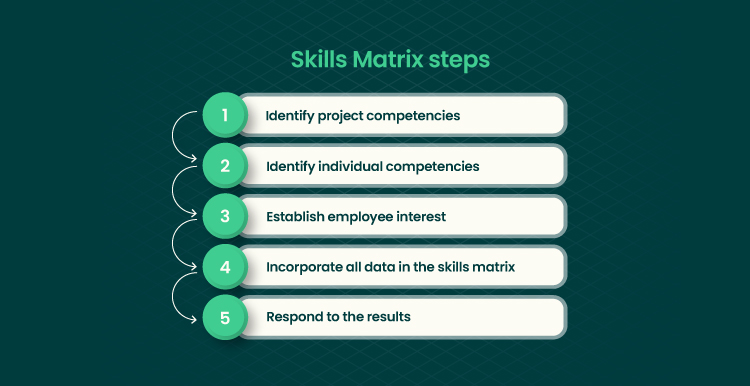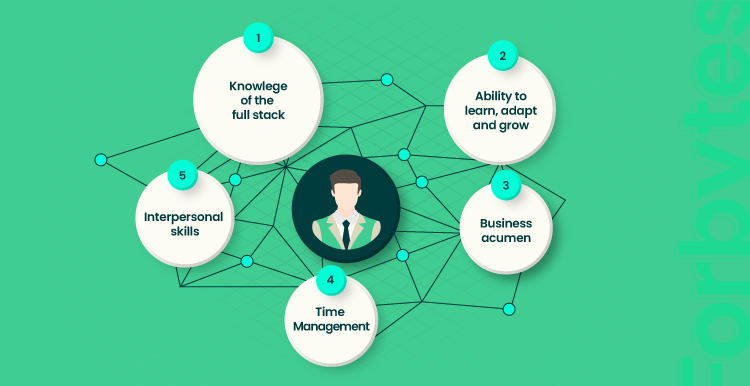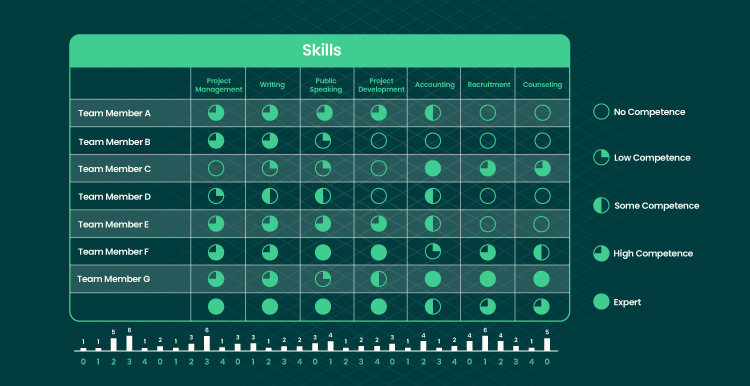Software engineering is complex. It’s both about building systems or writing code and having the right mix of skills, knowledge, and problem-solving abilities. For companies, this can be a real challenge: how do you move toward engineering-led innovation while keeping your teams productive and adaptable?
An engineering competency matrix can help. It’s a clear way to map your team’s skills, identify gaps, and align everyone with your innovation goals. In short, it helps you build stronger, more capable teams ready for the digital age.
In this article, we’ll explain what an engineering competency matrix is, why it matters, and how it can make your engineering team work smarter and faster.
What Is an Engineering Competency Matrix?
Have you ever wondered how to measure engineering competency across your business? The engineering competency matrix defines a person’s engineering skill level and competency to succeed in their role. It can be used to create a customized personal development plan and work towards goals. It is an excellent tool for understanding your team’s current level of competency concerning engineering, giving you an idea of where you should start with your project and how quickly you can grow.
A competency matrix is a go-to tool for recruiters. It assesses skills needed for a given role and describes the job responsibilities, the competencies required, and tangible deliverables. An engineering competency matrix lists the skills and areas of expertise you need to hire an excellent technical staff.
Skill matrix is suitable for organizations of any size looking to drive innovation by engaging engineers. With this tool, organizations can proactively identify what engineering types they need to develop a competitive advantage. The matrix also provides guiding forces to select and organize types of engineering competencies according to 4 general criteria: capability, leadership, focus, and innovation.
In short, an engineering competency matrix is a tool that can help an organization determine whether they have the “right people” for their engineering function in the project’s early stages. It might also be helpful for companies looking to hire more engineers or stay ahead of the curve and take full advantage of the talent opportunities in the marketplace.
How to Build an Engineering Competency Matrix That Works
To be successful in a rapidly changing tech landscape, it is important to build an engineering competency matrix and reevaluate it regularly. This allows you to maintain your engineering team’s skills up to date with the most cutting-edge technologies while ensuring you have the right people on board at the right time.
Whether your company is late to the competency matrix game and wants to be a part of the next wave of innovation, or you just want to refresh your memory on what a competency is, we think you will find the following list of to-dos helpful.
Step 1. Create a list of competencies
What are the core engineering skills that your organization needs to be successful?
List out the skills you consider must-haves for your engineering team. Start with different web development roles and create a list of core engineering skills focusing on priorities and rationale for each.
The list can look as follows:
- Technical;
- Communication, feedback, collaboration & community;
- Leadership;
- Delivery & effectiveness;
- Strategy.
They can be divided into two categories:
- Hard skills: writing, designing, understanding functional architecture, proficiency with programming languages, database management, coding, debugging, testing, learning, and understanding QA.
- Soft skills: collaboration, inter-team communication, resolution of disputes, and so forth.
Step 2. Group the sub-competencies and sub-skills
A growing trend in today’s job search is that companies no longer rely on general skills and competencies. But instead, they are breaking individual skills and competencies into small, more manageable sub-skills or even sub-competencies.
Every job description includes a laundry list of skills and abilities. The more sub-competencies and sub-skills you learn to group, the better you will understand how they interact and influence one another.
Step 3. Define each skill according to a competency
Companies’ typical business task is finding the best person for a specific job. To evaluate a candidate’s suitability to do a task, you can come up with a job-specific list of competencies and define skills for each.
First, look closely at what skills are essential in your chosen field. For example, if you’re a software development company, you might be looking for people with skills in programming, design, building, and maintaining robust IT systems. This type of skill defines competencies such as security, distributed systems, observability, and reliability.
Take a look at the image below to get a more meaningful understanding of how skills and competencies correlate.
Step 4. Create a spreadsheet of skills for engineers
When looking to figure out the skill set you need to start your next project, there’s no better tool than a spreadsheet.
Having a spreadsheet of skills is a great way to help engineers understand what a company expects from their input and what they need to learn to grow their careers. This spreadsheet can be shared with your engineers, or if they’re not in the same company, you could share it with a recruiter or hiring manager to make yourself stand out as an engineer that can hit the ground running.
Step 5. Collect feedback and road-test the matrix
Without a method of organizing and structuring feedback, it’s hard to get an actionable plan. With the help of simple testing, you can collect feedback, take action, and test the competencies against various job roles.
This is a great way to get a quick snapshot of your matrix performance and identify where you need to focus your efforts and what you need to improve. You can even use it to understand how your team members are performing.
The point of the engineering competencies matrix is to provide you with a simple way to distinguish, identify, and map the benefits of one strategy over another. By taking a competencies-based approach at the outset, you can build a skill-based hiring process and create a career pathway that aligns with the market’s demands.
How a Skill Matrix Helps Teams Work Smarter and Faster
What does engineering competency mean in the context of business? A competency matrix is a great way to develop and prioritize where your team invests time. It makes each skill and competency multidimensional and prioritized.
A competency matrix provides the foundation for HR, management, and collaboration amongst the set of personnel in the organization. What are some other benefits of using this tool?
Required skillset visualization
If you work for a large business, you should know your engineering competency to plan for changes that may occur in your role adequately. Many companies offer lists of “required skills” for the various roles. Still, these lists often don’t give you the best overall picture of the required skills and abilities — because they focus exclusively on technical requirements.
That’s where this list of engineering competencies comes in: it removes the focus on technology and provides a complete picture of what it takes to be an effective engineer. An engineering competency matrix identifies required skills for each role in an organization and provides a framework for evaluating candidates for those roles.
Bridged skill gap
Since an IT company usually has many different verticals, too many competencies can sometimes be overlooked. In this case, one of the most common challenges will be identifying gaps in the organization’s skill set. Engineers must have enough skills to complete all projects, no matter how big or small, or they’ll cause costly delays. But skills gaps can cause severe problems to your company’s culture and bottom line.
An engineering competency matrix can help eliminate skill gaps and improve quality of life due to better project planning, project initiation, and project planning analytics. The matrix highlights technical competencies for each job description in your HR system and helps companies adjust product designs and strategic initiatives based on their engineering competency levels. The long-term benefits could be worth billions of dollars.
Efficient resource allocation
What does the skill matrix have to do with work productivity? It’s all about how you manage. Resources are finite, and time is limited. If you don’t properly manage your talents, your company is losing time and money. You need to minimize downtime and boost the productivity of your whole team. The skill matrix is all about managing resources and developing the talent available to you.
As technology enters the organization, it changes the paradigm to nurture and develop skills better and more efficiently. The skill matrix enhances the organization’s overall productivity by creating greater access to the right skills across the right people.
Augmented recruiting process
It is not very common among employers to have a formal competency matrix that enables them to know their applicants’ skills, knowledge, and abilities. This can make it difficult for them to predict the future, but it can be made easy by the engineering competency matrix. By adding this matrix to the process, employers can identify measurable competencies crucial for a successful hire. The matrix allows them to create a profile for every candidate and tailor the interview process to their needs.
Job seekers might need to provide more information, such as evidence of technical skills, transferable soft skills, certifications, education, and work experience, to be considered for a position. With the engineering competency matrix, employers can compare candidates’ profiles and verify potential employees’ qualifications.
The skills that companies care about most are those that correlate with success in the workplace. For example, employers are more likely to consider someone with experience in computer programming skills as a candidate for an engineering position. Knowing these skills allows HRs to quickly find employees who are only interested in the positions that fit their skill set.
Advanced training and development programs
It’s no secret that employee training and motivation benefit everyone in the company. Knowing which skills your team lacks helps you identify the right education path for your employees. Companies build, maintain, and share knowledge and become more effective, profitable, and competitive.
As companies seek to bolster their workforce and meet increasing demands for higher levels of technical talent, the engineering competency matrix is emerging as a valuable tool that can enhance employee training and development. Employees are considered at the right competencies or levels at which they can perform their job requirements. Achieving competency in one area leads to increased capabilities in other areas. Engineering competency matrixes help organizations measure employee skill level and competency.
A competency matrix is a great learning tool that organizations use to document a person’s knowledge in a given field. It is a great way to identify gaps in knowledge and organize current knowledge, skills, and competencies and identify and maintain productivity across your engineering team.
Final Word
Whether you are a new company or an established enterprise interested in competing in the digital race, an engineering competency matrix provides your employees with an easy way to self-inspect their skills and offers a guide for continuous improvement. It allows you to keep track of your company’s structure and employees, provides solid backup for the HR department, and improves the efficiency and accuracy of a complicated process such as recruitment. But more crucially, a skills matrix makes it evident which skill shortages need to be filled right away and makes it easier to figure out how much it will cost.
Need help streamlining your business strategies and finding top-notch IT specialists? We are at your service. Contact us, and we will define the best ways to grow your team and company performance.

Our Engineers
Can Help
Are you ready to discover all benefits of running a business in the digital era?

Our Engineers
Can Help
Are you ready to discover all benefits of running a business in the digital era?










